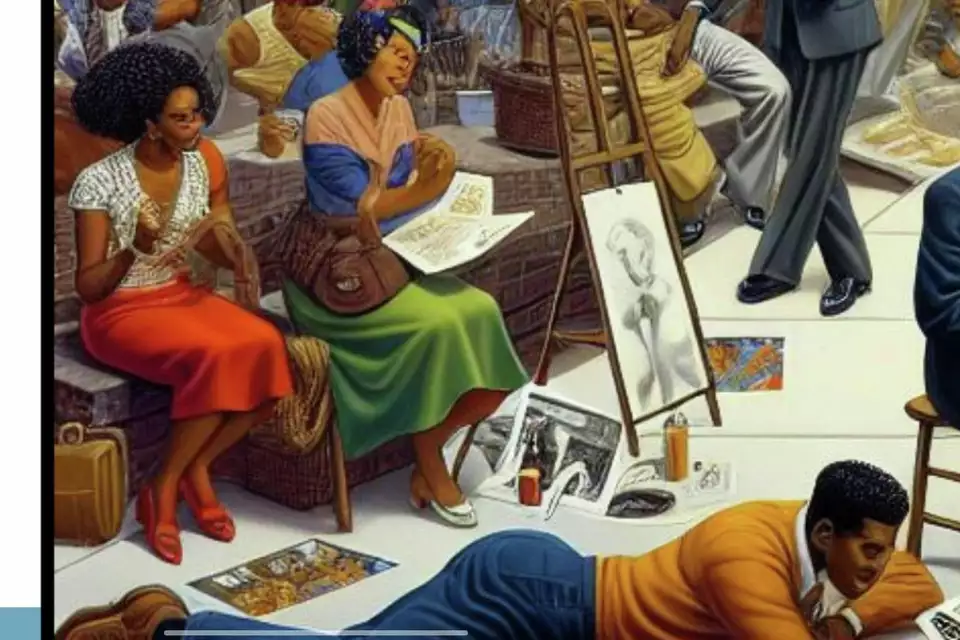Ugh.
The Harlem Renaissance produced a rich tapestry of poems, novels and paintings of Black life in the early 20th century, all expressing the artistry and brilliance of people whose equal citizenship and full humanity had long been denied.
Yet this February, when eighth graders in the Houston Independent School District sat down for a lesson about the movement’s significance, they were treated to a slideshow with zero images made by Harlem Renaissance artists.
Instead, students were shown two obviously AI-generated illustrations. Both depicted Black people with missing or monstrously distorted facial features, a tell-tale sign of “AI slop.”
Buildings pictured were inscribed with gibberish, including a misspelling of the word “Renaissance.”
And when students turned to a passage about poetry and literature in the Harlem Renaissance, they found more AI-generated illustrations in the margins — but no actual poems. With strictly-timed exercises forcing students to move swiftly through a set of multiple-choice questions like those they would see on end-of-year tests, there was little time for verse.
On May 8, the HISD Board of Managers approved the controversial curriculum that contains lessons like this one for use again next year. The rubber stamp was expected, given the Board’s unstinting support for the state-appointed superintendent Mike Miles and his New Education System (NES).
But this decision is only the latest of many reasons why we — as educators at Rice University and parents of HISD students — are so concerned about the district’s direction since its takeover by the Texas Education Agency in 2023.
[…]
Little is publicly available about the content of HISD’s centrally planned curriculum, aside from the district’s decision to hire a new “artificial intelligence” company called Prof Jim to help generate worksheets, slides and reading passages for use in Miles’s schools. HISD is the company’s first school-district client.
Most Houstonians therefore remain in the dark about the district’s materials, which are already part of the curricula at all but a handful of HISD campuses. In our experience, it’s not always clear where a given lesson has come from. Elements of our own children’s curriculum this year were culled from or generated by a variety of sources, including Canva, Edmentum, Khanmigo, voronoiapp.com and flocabulary.com. More sources are listed in the district’s AI guidebook.
HISD parents, though, can see what is going on. All school-year long, in online forums and community meetings, we have shared troubling findings from our students’ computers and backpacks: worksheets riddled with errors and lifeless lessons that stifle curiosity and emphasize standardized tests.
We commiserate about the lazy misspellings in district-provided PowerPoints (Brahmins, not Bhramins!), YouTube videos of questionable origin, and generally confounding discussion questions — with incorrect punctuation to boot: “What is the exclamation point(s) to something that surprised you.”
We try to laugh about our most absurd discoveries, like the worksheet on transportation technology that asked seventh graders to analyze a picture of an automobile mashed up with a chariot — pulled by an AI-generated horse with three hind legs.
Or the one for a third-grade “Art of Thinking” class that asks students to match prompts to a chatbot’s responses and then “identify how AI positively impacts critical thinking.”
Or the Harlem Renaissance slides without Harlem Renaissance art.
All of these examples come from students and parents we personally know, but we worry over the future for all of Houston’s children as alarm bells about HISD sound.
[…]
For-profit “educational technology” companies like Prof Jim are eager to turn the crisis of public disinvestment into a money-making opportunity. In a public talk last year, the company’s CEO and founder proudly claimed that, “We are now able to use AI to automatically create things like slide decks for teachers … You just push a button.” He predicted that within 10 years, robots would be good enough to enter physical classrooms and teach.
Hell no to that. This is from a long op-ed that ran in Sunday’s print edition. Among many other things, I feel confident saying we would not be in this position of having moronic AI content in our schools if we still had elected representation. When we finally do get that back, undoing or at least very strictly reviewing and revising this bullshit needs to be a top priority. I would argue that imposing this kind of curriculum, with its associated costs, is outside the bounds of Mike Miles’ mandate. But of course he’s never felt confined by any mandate, and he can simply wave away any unfortunate obstacles. It’s going to be such a big damn celebration when he finally slinks out of town.

